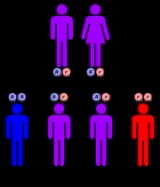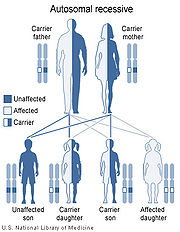
Oguchi disease
Encyclopedia
Oguchi disease, also called congenital stationary night blindness, Oguchi type 1 or Oguchi disease 1, is an autosomal
recessive form of congenital stationary night blindness
associated with fundus
discoloration and abnormally slow dark adaptation
.
with diffuse yellow or gray coloration of the fundus under light conditions. After two to three hours in total darkness, the normal color of the fundus returns. This effect is known as the Mizuo-Nakamura phenomena
, and is thought to be caused by the overstimulation of rod cells.
 Several mutations have been implicated as a cause of Oguchi disease. These include mutation
Several mutations have been implicated as a cause of Oguchi disease. These include mutation
s in the arrestin
gene or the rhodopsin kinase
gene.
The condition is more frequent in individuals of Japanese
ethnicity.
Autosome
An autosome is a chromosome that is not a sex chromosome, or allosome; that is to say, there is an equal number of copies of the chromosome in males and females. For example, in humans, there are 22 pairs of autosomes. In addition to autosomes, there are sex chromosomes, to be specific: X and Y...
recessive form of congenital stationary night blindness
X-linked congenital stationary night blindness
X-linked congenital stationary night blindness is a rare X-linked non-progressive retinal disorder. It has two forms, complete, also known as type-1 , and incomplete, also known as type-2 , depending on severity. In the complete form , there is no measurable rod cell response to light, whereas...
associated with fundus
Fundus (eye)
The fundus of the eye is the interior surface of the eye, opposite the lens, and includes the retina, optic disc, macula and fovea, and posterior pole. The fundus can be viewed with an ophthalmoscope. The term may also be inclusive of Bruch's membrane and the choroid.The color of the fundus varies...
discoloration and abnormally slow dark adaptation
Adaptation (eye)
In ocular physiology, adaptation is the ability of the eye to adjust to various levels of darkness and light.-Efficacy:The human eye can function from very dark to very bright levels of light; its sensing capabilities reach across nine orders of magnitude. This means that the brightest and the...
.
Characteristics
Oguchi disease presents as a congenital, static hemeralopiaHemeralopia
Hemeralopia is the inability to see clearly in bright light and is the exact opposite of Nyctalopia . Hemera was the Greek goddess of day and Nyx was the goddess of night. However, it has been used in an opposite sense by many non-English-speaking doctors...
with diffuse yellow or gray coloration of the fundus under light conditions. After two to three hours in total darkness, the normal color of the fundus returns. This effect is known as the Mizuo-Nakamura phenomena
Mizuo-Nakamura phenomenon
The Mizuo-Nakamura Phenomenon, is a phenomenon observed in Oguchi's disease. It was named after Gentaro Mizuo and Bunpei Nakamura , Japanese opthalmologists....
, and is thought to be caused by the overstimulation of rod cells.
Cause and Genetics

Mutation
In molecular biology and genetics, mutations are changes in a genomic sequence: the DNA sequence of a cell's genome or the DNA or RNA sequence of a virus. They can be defined as sudden and spontaneous changes in the cell. Mutations are caused by radiation, viruses, transposons and mutagenic...
s in the arrestin
Arrestin
Arrestins are a small family of proteins important for regulating signal transduction.-Function:Arrestins were first discovered as a part of a conserved two-step mechanism for regulating the activity of G protein-coupled receptors in the visual rhodopsin system by Hermann Kühn and co-workers and...
gene or the rhodopsin kinase
Rhodopsin kinase
Rhodopsin kinase is a serine/threonine-specific protein kinase involved in phototransduction.-See also:* Rhodopsin* Beta adrenergic receptor kinase* G-protein coupled receptor kinases-External links:...
gene.
| Type | OMIM | Gene |
|---|---|---|
| Type 1 | SAG SAG (gene) S-arrestin is a protein that in humans is encoded by the SAG gene.-Further reading:... |
|
| Type 2 | GRK1 |
The condition is more frequent in individuals of Japanese
Japanese people
The are an ethnic group originating in the Japanese archipelago and are the predominant ethnic group of Japan. Worldwide, approximately 130 million people are of Japanese descent; of these, approximately 127 million are residents of Japan. People of Japanese ancestry who live in other countries...
ethnicity.

